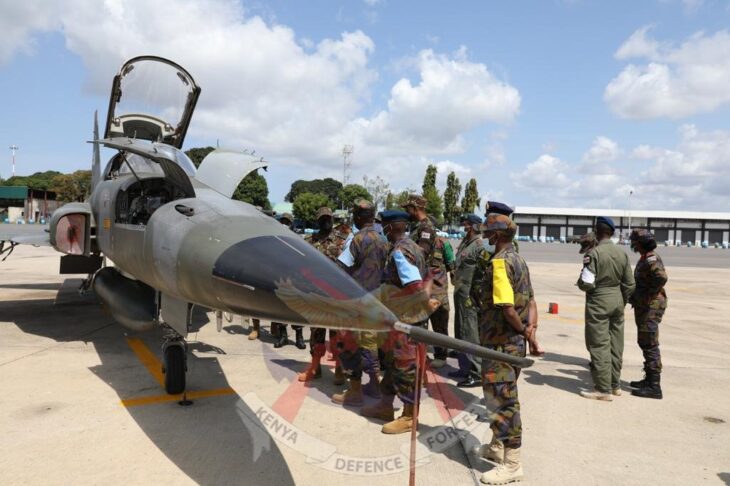NAIROBI, Kenya, Jul 29- It is now 10 years since the Kenya Defence Forces (KDF) troops, now under the Africa Union Mission in Somalia (AMISOM), were deployed in Somalia, to degrade the threat of terror posed by the Al-Qaeda linked Al-Shabaab terrorists.
There have been calls for withdrawal of the Kenyan troops from Somalia, due to the human and financial cost that it has brought to the country.
But such a move, security experts and international players say, must be made in a cautious manner, to ensure the gains made are not lost.
And those are sentiments of KDF Chief of Defence Forces (CDF) General Robert Kibochi, when he spoke to the Kenya Broadcasting Corporation (KBC).
“There is no doubt that war is costly in whatever character, in whatever form, but it is costlier and catastrophic, not to engage in war,” he said.
“If you have been pushed to the corner where the country employ the instrument of last result, once you engage in it, it is important for people to understand it is going to be costly both in human life and in the economy. But it is costlier if you do not engage.”
A lot has happened since the KDF soldiers went to Somalia; towns and villages have been liberated from terrorists and Somalia has a form of order but the army has also suffered major setbacks.
One such moment was on January 15, 2016, when Al-Shabaab militants attacked a Kenyan run AMISOM army base in the town of El-Adde in Gedo region.
“It was a terrible attack,” the CDF said, but added that lessons have been learnt and converted into a doctrine- all the way to the training institutions.
“This was one of the worst attacks we have suffered as KDF. We have had to relook at what we would have done better. That this is the essence of having a force that is on continuous learning curve,” he said. This remains the largest military defeat in the Kenyan history.
The total size of the troops that day has been generally put at around 200 Kenyan troops present.
Years later, it is not clear how many lost their lives on the fateful day.
Former CDF General Samson Mwathethe said the explosion at El Adde was three times more powerful than the 1998 United States embassy bombings in Nairobi.
A few days later, the alleged mastermind of the El Adde attack and leader of the Al Shabaab “Abu Zubair battalion”, Maalim Janow, was killed in retaliatory airstrikes by the KDF.
“We learnt from it and we are now better,” the CDF said. “We had to rethink and be ahead of the enemy. Force protection became one of the major areas to engage in.”
But the situation has even become complicated, with the terror group now resulting to using drones to launch attacks against civilians and soldiers.
When KDF went to Somalia, he said encountering Improvised Explosive Device attacks was a major challenge.
“Today, they are using drones to carry IED’s…you have to harden your overhead protection from aerial attacks,” he said.
“There is a continuous learning in this engagement and I can assure you, all these lessons we learn, we translate them into a doctrine…we take them training institutions.”
-What next for AMISOM-
“We cannot leave (Somalia) until the conditions are right,” General Kibochi said.
He said the next phase would be restructuring AMISOM, so that it can become a multi-dimensional mission.
“What we need now is to bring in other actors,” he said, saying the next phase is stabilization of Somalia and handing over the security responsibilities to the Somali National Army (SNA).
“There is now way we are going to be there forever. But we cannot leave until the conditions are right because the gains that have been made for the last 10 years will be lost.”
This means that as the troops engage the enemy, there will be civilians engaging in other activities like schools and road construction in Somalia.
He also said that going forward, AMISOM which currently gets funded by the European Union, should become a peacekeeping mission under the United Nations Security Council.
The need for this, he said, “is to ensure there is predictable funding that will be able to deliver the final successes for Somalia. It is in our interest to have a stable Somalia.”
By the end of December this year, he said a decision will be made on how to reconfigure AMISOM.
Currently the military component is comprised of troops drawn from Uganda, Burundi, Djibouti, Kenya and Ethiopia who are deployed in six sectors covering south and central Somalia.
Ugandan troops are deployed in Sector 1, which comprises the regions of Banadir, and Lower Shabelle.
Kenyan forces are responsible for Sector 2 comprising Lower and Middle Jubba. Sector 3 comprising Bay and Bakool as well as Gedo (Sub Sector 3) comes under Ethiopian command.
Djiboutian forces are in charge of Sector 4 which covers Hiiraan and Galgaduud while Burundian forces are in charge of Sector 5 which covers the Middle Shabelle region.
Want to send us a story? Contact Shahidi News Tel: +254115512797 (Mobile & WhatsApp)


